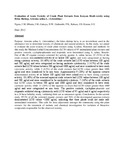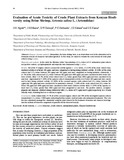| dc.description.abstract | Purpose: Artemia salina L. (Artemiidae), the brine shrimp larva, is an invertebrate used in the alternative test to determine toxicity of chemicals and natural products. In this study, we aimed to evaluate the acute toxicity of crude plant extracts using A.salina.
Materials and methods: In this study the Medium Lethal Concentrations (LC50 values) of 45 antimalarial plant extracts and positive controls, cyclophosphamide and etoposide were determined using A. salina.
Results: Out of the 45 organic extracts screened for activity against A. salina larvae, 23 (51%) of the crude extracts dem-onstrated activity at or below 100 μg/ml, and were categorized as having strong cytotoxic activity, 18 (40%) of the crude extracts had LC50 values between 100 μg/ml and 500 μg/ml, and were categorized as having moderate cytotoxicity, 2 (4.5%) of the crude extracts had LC50 values between 500 μg/ml and 1000 μg/ml, and were considered to have weak cyto-toxic activity, while 2 (4.5%) of the crude extracts had LC50 values greater than 1000 μg/ml and were considered to be non toxic. Approximately 9 (20%) of the aqueous extracts demonstrated activity at or below 100 μg/ml and were consid-ered to have strong cytotoxic activity, 18 (40%) of the screened aqueous crude extracts had LC50 values between 100 μg/ml and 500 μg/ml and were considered to be moderately cytotoxic, 7 (16%) of the crude extracts had LC50 values be-tween 500 μg/ml and 1000 μg/ml and were considered to have weak cytotoxic activity while 11 (24%) of the aqueous ex-tracts had LC50 values greater than 1000 μg/ml and were categorized as non toxic. The positive controls, cyclophos-phamide and etoposide exhibited strong cytotoxicity with LC50 values of 95 μg/ml and 6 μg/ml respectively in a 24 hour lethality study, validating their use as anticancer agents.
Conclusions: In the current study, 95.5% of all the screened organic extracts and 76% of the investigated aqueous extracts demonstrated LC50 values <1000 μg/ml, indicating that these plants could not make safe antimalarial treatments. This calls for dose adjustment amongst the community using the plant extracts for the treatment of malaria and chemical investiga-tion for isolation of bioactive compounds responsible for the observed toxicity. | en |


